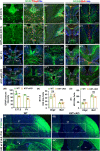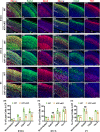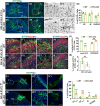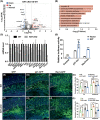Krüppel-like factor 7 deficiency disrupts corpus callosum development and neuronal migration in the developing mouse cerebral cortex
- PMID: 37401095
- PMCID: PMC10467035
- DOI: 10.1111/bpa.13186
Krüppel-like factor 7 deficiency disrupts corpus callosum development and neuronal migration in the developing mouse cerebral cortex
Abstract
Krüppel-like Factor 7 (KLF7) is a zinc finger transcription factor that has a critical role in cellular differentiation, tumorigenesis, and regeneration. Mutations in Klf7 are associated with autism spectrum disorder, which is characterized by neurodevelopmental delay and intellectual disability. Here we show that KLF7 regulates neurogenesis and neuronal migration during mouse cortical development. Conditional depletion of KLF7 in neural progenitor cells resulted in agenesis of the corpus callosum, defects in neurogenesis, and impaired neuronal migration in the neocortex. Transcriptomic profiling analysis indicated that KLF7 regulates a cohort of genes involved in neuronal differentiation and migration, including p21 and Rac3. These findings provide insights into our understanding of the potential mechanisms underlying neurological defects associated with Klf7 mutations.
Keywords: corpus callosum; krüppel-like factor 7; neocortex; neurogenesis; neuronal migration.
© 2023 The Authors. Brain Pathology published by John Wiley & Sons Ltd on behalf of International Society of Neuropathology.
Conflict of interest statement
The authors declare no competing or financial interests.
Figures







Similar articles
-
KLF7 orchestrates hippocampal development through neurogenesis and Draxin-mediated neuronal migration.Development. 2025 Oct 15;152(20):dev204718. doi: 10.1242/dev.204718. Epub 2025 Aug 5. Development. 2025. PMID: 40762575 Free PMC article.
-
Krüppel-like Transcription Factor 7 Is a Causal Gene in Autism Development.Int J Mol Sci. 2022 Mar 21;23(6):3376. doi: 10.3390/ijms23063376. Int J Mol Sci. 2022. PMID: 35328799 Free PMC article.
-
De novo variants in KLF7 are a potential novel cause of developmental delay/intellectual disability, neuromuscular and psychiatric symptoms.Clin Genet. 2018 May;93(5):1030-1038. doi: 10.1111/cge.13198. Epub 2018 Jan 25. Clin Genet. 2018. PMID: 29251763
-
Molecular function of Krüppel-like factor 7 in biology.Acta Biochim Biophys Sin (Shanghai). 2023 May 24;55(5):713-725. doi: 10.3724/abbs.2023061. Acta Biochim Biophys Sin (Shanghai). 2023. PMID: 37227154 Free PMC article. Review.
-
[Research progress of Krüppel-like factor 7].Sheng Li Xue Bao. 2016 Dec 25;68(6):809-815. Sheng Li Xue Bao. 2016. PMID: 28004076 Review. Chinese.
Cited by
-
Distribution and functional significance of KLF15 in mouse cerebellum.Mol Brain. 2025 Jan 21;18(1):3. doi: 10.1186/s13041-025-01172-3. Mol Brain. 2025. PMID: 39838470 Free PMC article.
-
Multiplexed CRISPRi Reveals a Transcriptional Switch Between KLF Activators and Repressors in the Maturing Neocortex.bioRxiv [Preprint]. 2025 Feb 15:2025.02.07.636951. doi: 10.1101/2025.02.07.636951. bioRxiv. 2025. PMID: 39975013 Free PMC article. Preprint.
-
Sex-specific hypothalamic neuropathology and glucose metabolism in an amyloidosis transgenic mouse model of Alzheimer's disease.Cell Biosci. 2024 Sep 13;14(1):120. doi: 10.1186/s13578-024-01295-5. Cell Biosci. 2024. PMID: 39272160 Free PMC article.
-
Bioinformatic Evaluation of KLF13 Genetic Variant: Implications for Neurodevelopmental and Psychiatric Symptoms.Genes (Basel). 2024 Aug 11;15(8):1056. doi: 10.3390/genes15081056. Genes (Basel). 2024. PMID: 39202416 Free PMC article.
-
KLF7 orchestrates hippocampal development through neurogenesis and Draxin-mediated neuronal migration.Development. 2025 Oct 15;152(20):dev204718. doi: 10.1242/dev.204718. Epub 2025 Aug 5. Development. 2025. PMID: 40762575 Free PMC article.
References
-
- Martinez‐Cerdeno V, Noctor SC, Kriegstein AR. The role of intermediate progenitor cells in the evolutionary expansion of the cerebral cortex. Cereb Cortex. 2006;16(Suppl 1):i152–61. - PubMed
-
- Angevine JB Jr, Sidman RL. Autoradiographic study of cell migration during histogenesis of cerebral cortex in the mouse. Nature. 1961;192:766–8. - PubMed
Publication types
MeSH terms
Substances
LinkOut - more resources
Full Text Sources
Medical
Miscellaneous

